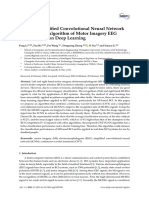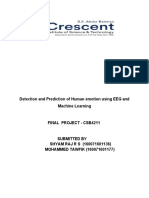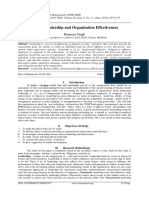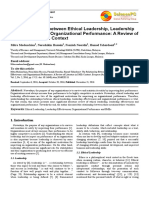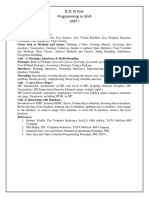A Graphical User Interface For EEG Analysis and Classification
A Graphical User Interface For EEG Analysis and Classification
Uploaded by
azmiCopyright:
Available Formats
A Graphical User Interface For EEG Analysis and Classification
A Graphical User Interface For EEG Analysis and Classification
Uploaded by
azmiOriginal Title
Copyright
Available Formats
Share this document
Did you find this document useful?
Is this content inappropriate?
Copyright:
Available Formats
A Graphical User Interface For EEG Analysis and Classification
A Graphical User Interface For EEG Analysis and Classification
Uploaded by
azmiCopyright:
Available Formats
ISSN(Online): 2320-9801
ISSN (Print): 2320-9798
International Journal of Innovative Research in Computer
and Communication Engineering
(A High Impact Factor, Monthly, Peer Reviewed Journal)
Website: www.ijircce.com
Vol. 6, Issue 6, June 2018
A Graphical User Interface for EEG Analysis
and Classification
YahyaT. Qassim1, DhafirA. Alneema 2,Modhar A.Hummoudi2
Sessional Lecturer, School of Electronic Engineering,Griffith University, Brisbane, Australia1
Lecturer, Department of Computer Engineering,College of Engineering, University of Mosul, Mosul, Iraq2
ABSTRACT: The Electroencephalogram (EEG) data measured from the human scalp represent a vital and non-
invasive tool in many psychological and medical applications. This data can be concurrently recorded over tens of brain
channels for extended periodsand for many participants. As a result, the resultant volume of the data acquired is large
and require not only a significant storage area on the computer hard drive but analysing such amount of data to
extracting useful information is painful as well. In this paper, we have developed a graphical user interface (GUI) to
facilitate the preparation and analysis of the EEG data measured through the oddball test and for several participants.
The design includes signal loading and preparation, signal classification and wavelet analysis. Results are displayed in
detail in both numbers and figures. The designed GUI represents a significant approach in analysing any selected EEG
by channel, trial or participant with the desired parameters and the targeted method of analysis. The analysis outcome
can be performed easily and quickly. For one participant, when training both the LDA and the wavelet classifiers, in the
LDA we obtained a sensitivity equal 57.448 and specificity 56.22 whereas in the wavelet classifier (coiflet1 filter), the
sensitivity is 55.19 and specificity is 55.34. Here the LDA classifier gave better results.
KEYWORDS: Classification, EEG, ERP, GUI, Statistical analysis.
I. INTRODUCTION
Electroencephalogram (EEG) and Evoked Related Potential (ERP) signals are very weak potential recording from
the scalp generated by the brain [1]. Their frequencies are in the range 0.5-100 Hz and their amplitudes can goes up to
100μV [2]. It gives a millisecond resolution of information for the study of human cognition states depending on the
selection of the appropriate brain channels that reflect the cognition processes being studied. In most of the cases
extracting useful information from the EEG require a conversion process on these signals to another useful form. The
EEG is the normal measurement of these signals whereas the ERP is the measurement of these signals under an
external stimulus such as the oddball test. The purpose of the stimulus is to extract important components (for example
the P300) from the EEG when the participant attention raise suddenly. The first 1000ms of the EEG measured under
stimulus contains the expected ERP components since the reaction of the participants starts in 300ms post stimulus.
The P300 arise 300-600ms post stimulus [3]. Fig. 1 illustrates the EEG recording procedure with further processing
towards ERP extraction and signal analysis.
The EEG is concurrently measured from tens of brain channels such as 64 or 128 for the same participant and for
hundreds of trials in case of extracting the ERP components. As a result, the amount of data recorded is large and
extracting a useful information from such amount of data is hopeless. Data needs to be sorted by participants, by
channels and by trials as well. Single EEG trials need to be inspected by eye and unsuccessful trials (happen due to eye
or muscle movement) should be excluded from the group of data [4].
In this paper, we have presented a Graphical User Interface (GUI) that can load and prepare the EEG for further
analysis including the extraction of useful information from the huge amount of EEG data recorded and display the
results in numbers and different sort of graphs. Our design is built on the available EEGLAB tool for EEG analysis and
it adds statistics essential for these analyses. Our GUI toolbox simplifies EEG analysis for novice and experienced
users.
Copyright to IJIRCCE DOI: 10.15680/IJIRCCE.2018.0606053 6451
ISSN(Online): 2320-9801
ISSN (Print): 2320-9798
International Journal of Innovative Research in Computer
and Communication Engineering
(A High Impact Factor, Monthly, Peer Reviewed Journal)
Website: www.ijircce.com
Vol. 6, Issue 6, June 2018
II. LITERATURE SURVEY
In [5] authors had developed a GUI for EEG recording during Transcranial Magnetic Stimulation (TMS). Their
concerns were to develop a standard method to recover the TMS evoked potentials that often masked by the artifacts
since the EEG is highly sensitive to artifacts. Another EEG based GUI is spotted in [6], the purpose of this GUI
program is to enable the users to observe changes in brain neuro activity when compared to a previously defined
electrographic state and behavioral. The procedures of the study was experienced on live animals. EEG Events were
detected using the Short Time Fourier Transform (STFT), which show a short time epochs of the EEG. After 10
minutes of EEG recording and injection of pentylenetetrazol, the authors’ spotted two high-amplitude bursts near 4 and
7 min. The two bursts were seizure events. In [7], a more complex GUI program was developed and called the SPM8.
The design was built to perform in addition to the standard EEG preprocessing, three analysis tools. The first is the
scalp-maps statistical analysis, EEG images in the time-frequency domain and the general linear model to reconstruct
3D source images. The authors employed the random field theory to correct the reconstructed images for multiple
comparisons. The second tool was the Bayesian M/EEG source reconstruction with support to group analysis and
simulation of EEG. The third analysis tool was the dynamic causal modelling (DCM) as a method that combine data
analysis with neural modelling.
III. PROPOSED METHODOLOGY AND DISCUSSION
A. EEG recording
The EEG epochs were recorded through the oddball test according to the 10/20 international system and from 32-
electrode cap. Data were collected from 19 participants. The Griffith University ethics number for human research
was (PSY/92/09/HREC).
B. Algorithms Presented
In our GUI design, the EEG passes through optional pre-analysis steps including down sampling and EEG
truncation. The down sampling reduces the number of EEG samples for faster analysis whereas the truncation keeps the
first 1000ms of data. Further recording of the EEG is not necessary in ERP recordings since presenting the stimulus,
Copyright to IJIRCCE DOI: 10.15680/IJIRCCE.2018.0606053 6452
ISSN(Online): 2320-9801
ISSN (Print): 2320-9798
International Journal of Innovative Research in Computer
and Communication Engineering
(A High Impact Factor, Monthly, Peer Reviewed Journal)
Website: www.ijircce.com
Vol. 6, Issue 6, June 2018
take a reaction to that stimulus are all happen in the first 1000ms of the recording. The classification algorithms
employed are the Linear Discriminant Analysis (LDA) under the Fischer classification algorithm and the Wavelet
Analysis (WA). The LDA is an approach used to find a linear combination of features that characterizes or separates
two or more EEG epochs [8].
1. LDA classifier
In brief, The LDA for two sets of data is firstly to compute the mean of entire data set as follows:
= × + × eq. (1)
Where and are the mean of each data set and is the mean of the entire data. and are the apriori
probabilities of the classes, it assumed to be 0.5. Then the scatter measures computed as in equations (2) and (3):
= ∑ ×( ) eq. (2)
For the two-class problem:
= 0.5 × + 0.5 × eq. (3)
The next step is to calculate the covariance matrices and the between-class scatter formula ending with finding the
Euclidean distance, where the smallest Euclidean distance among n distances classifies the test vector as belonging to
class n.
2. DWT Classifier
The DWT is a powerful signal processing analysis tool. The key advantage of the wavelet transform is the ability to
adapt to features in the spatial domain. Example of such features are the varying behaviour of frequency and signal
discontinuities. The localization of wavelets allows processing the data in a region without affecting other data
outside this region [9]. In this paper, 60% of data are selected to training the classifier and 40% for the real
classification (testing).
IV. THE EEG GUI AND EXPERIMENTAL RESULTS
The EEG GUI is developed with MATLAB programming language for EEG presentation and statistical analysis:
LDA classification and the discrete wavelet transform. It can be seen in Fig. 2.
It can be noticed from Fig.2 that the GUI contains several blocks of push buttons, static text, edit text, axes blocks
and popup menus. The blocks are sorted into group in order to perform a specific task per group. The following explain
the operation of our GUI:
Load the data by pressing LOAD DATA button then set the path of the provided data. The data will be loaded in a
few seconds and the indicator “data?” changes to “data loaded” as shown in the figure. The next step is to down sample
the EEG epoch to one of the available options: 32, 64 or 128 sample/sec according to the blue popup menu “sample
rate” then pressing the “downsampling” button. The selected sampling rate will appear in the blue static text block. The
“down conversion” step is optional to the user.Data truncation is another optional pre-analysis step in which the first
1000ms only is kept from the whole EEG epoch of 1536ms. The data truncation process is optional as well and the data
can be restored to its original length as the user wish. Now the user can start plotting the EEG, use the LDA classifier,
the wavelet panel, or do a comprehensive analysis. These are all explained in detail.
In the “sample EEG plot” panel, the user is able to see the EEG signal by selecting the participant (1-19), one of the
scalp channels (F3,Fz, F4, C3, Cz, C4, P3, Pz, P4) and the trial number (1-295). By pressing the “plot orig data”, the
whole EEG epoch is plotted. There is an option to plot down sampled data or truncated data as well. It can be noticed
Copyright to IJIRCCE DOI: 10.15680/IJIRCCE.2018.0606053 6453
ISSN(Online): 2320-9801
ISSN (Print): 2320-9798
International Journal of Innovative Research in Computer
and Communication Engineering
(A High Impact Factor, Monthly, Peer Reviewed Journal)
Website: www.ijircce.com
Vol. 6, Issue 6, June 2018
that two yellow buttons are presented in the GUI. These are used to save settings of parameters in order to repeat
analysis later by pressing “save settings” and then “Restore”.
Fig.2: The EEG GUI Developed for EEG Presentation and Statistical Analysis
Linear Discriminant Analysis (LDA) button: the LDA require down sampling first otherwise a warning message
appear advising to down sample the data. The EEG sensitivity and specificity are calculated under Fischer
classification algorithm for a specific participant and results appeared in the allocated static box. Participant selection is
done first, and then a sample trial of 20, 30, or 35 is need to be selected before data training. The histograms will
appear on the axes blocks for trained data.Data testing is performed as a random selection on the rest of oddball trials
for the same participant and on same random frequent trials (not used in the training step). The histogram of tested data
is shown after pressing the button (Testing (cross validation)).
Discrete Wavelet Transform analysis: selecting a specific wavelet filter from the “family” popup menu and the depth of
analysis from the “level depth” popup menu to perform the wavelet classification on the same participant and same
sample trial. The histograms will appear as in the LDA on the same axes. The testing (cross validation) step is also
available for untrained data.
The four indicators: #frequent, #oddball, #trained and #tested, show the total frequent trials, total oddballs, number of
trained epochs and number of tested epochs respectively. When selection moves to another participant, those four
Copyright to IJIRCCE DOI: 10.15680/IJIRCCE.2018.0606053 6454
ISSN(Online): 2320-9801
ISSN (Print): 2320-9798
International Journal of Innovative Research in Computer
and Communication Engineering
(A High Impact Factor, Monthly, Peer Reviewed Journal)
Website: www.ijircce.com
Vol. 6, Issue 6, June 2018
indicators show ‘-‘, where the new calculations appear as soon as classification started. In total, there are 8 indicators to
show the sensitivity and specificity for the LDA and wavelet on trained and tested epochs.
The function of the “comprehensive button” is to combine both the LDA and the wavelet calculations in one press and
save the results of SEN and SPC in the current folder measured at specific parameters. Two files will be generated
exp.txt and exp2.txt. Those files contains the LDA and wavelet analysis for all participants including participant
number and titles. However, only numbers are included in the files. The format of the contents is the same when the file
is opened outside MATLAB. This helps using the file with another software package such as SPSS.
The following results is an example of the designed GUI, as in Fig. 2, 30 samples of data are used for the classifier,
then a new 30 samples are tested for the cross validation. For participant 16, and after training both the LDA and the
wavelet classifiers, in the LDA we obtained a sensitivity equal 57.448 and specificity 56.22 whereas in the wavelet
classifier (coiflet1 filter), the sensitivity is 55.19 and specificity is 55.34. Here the LDA classifier gave better results.
V. CONCLUSION AND FUTURE WORK
This paper has presented a formal EEG GUI that include various EEG analysis and presentation tools. This GUI offer
many options to the user for preparing the EEG samples required to perform the nominated task. From the
classification tools included, the LDA classification sensitivity and specificity for both trained and tested data were
clearly presented and it shows better classification results presented than the wavelet classifications. However, wavelet
classifications depend in addition to the participants selected, to the wavelet filter family as well. Future trends will
develop this GUI further adding additional classification tools such as neural network and random forest. The buttons
are already prepared for these powerful tools as shown in Fig. 2.
REFERENCES
1. M. Teplan, Fundamentals of EEG measurement, Meas. Sci. Rev. 2 (2002).
2. Yahya T. Qassim, Tim R.H, Cutmore, Daniel A. James and David Rowlands, ‘Wavelet Coherence of EEG Signals for a Visual Oddball
Task’, Computers in Biology and Medicine, Volume 43(1), pp. 23-31, 2013.
3. J. Polich, Updating P300: an integrative theory of P3a and P3b, Clin,.Neurophysiol. 118 (2007) 2128–2148.
4. D.E.J. Linden, The P300: where in the brain is it produced and what it does it tell us? The Neurosci. 11 (2005) 563–576.
5. SravyaAtluri, Matthew Frehlich, Ye Mei, Luis Garcia Dominguez, Nugel C. Rogasch, Willy Wong, Zafiris J. Daskalakis and
FaranakFarzan, ‘TMSEEG: A MATLAB-Based Graphical User Interface for Processing Electrophysiological Signals during Transcranial
Magnetic Stimulation’, Frontiers in Neural Circuits, doi: 10.3389/fncir.2016.00078, 2016.
6. Justin Sick, Eric Bray, AmadeBregy, W Dalton Dietrich, Helen M Bramlett and Thomas Sick, ‘EEGgui: a Program Used to Detect
Electroencephalogram Anomalies after Traumatic Brain Injury’, Source Code for Biology and Medicine, pp. 1-7, 2013.
7. Vladimir Litvak, JeremieMattout, Stefan Kiebel, Christophe Phillips, Richard Henson, James Kilner, Gareth Barnes, Robert Oostenveld,
Jean Daunizeau, GuilaumeFlandin, Will Penny and Karl Friston, ‘EEG and MEG Data Analysis in SPM8’, Computational Intelligence
and Neuroscience, doi: 10.1155/2011/852961, 2011.
8. S. Balakrishnama and A, Ganapathiraju, ‘Linear Discriminant Analysis- A Brief Tutorial’, Institute for Signal and Information
Processing, Department of Electrical Engineering and Computer Engineering, Mississippi State University.
9. Jaison Bennet, Chilambuchelvan Arul Ganaprakasam and Kannan Arputharaj, ‘A Discrete Wavelet Based Feature Extraction and Hybrid
Classification Technique for Microarray Data Analysis’, The Scientific World Journal, Volume 2014, Article ID 195470,
http://dx.doi.org/10.1155/2014/195470, 2014
Copyright to IJIRCCE DOI: 10.15680/IJIRCCE.2018.0606053 6455
You might also like
- Cyber Threat Hunting MEAP V09 (Nadhem AlFardan) (Z-Library)Document457 pagesCyber Threat Hunting MEAP V09 (Nadhem AlFardan) (Z-Library)SamNo ratings yet
- EEG Based Brain Controlled Wheelchair For Physically Challenged PeopleDocument4 pagesEEG Based Brain Controlled Wheelchair For Physically Challenged PeopleazmiNo ratings yet
- Es2009 5Document10 pagesEs2009 5DijonNetoNo ratings yet
- Applsci 10 01605 v2Document14 pagesApplsci 10 01605 v2Susan KunkleNo ratings yet
- Analysis of The Comparison of Selective Cloud Vendors ServicesDocument8 pagesAnalysis of The Comparison of Selective Cloud Vendors Servicesneirew777No ratings yet
- Ij70606025 Ijirset GayatriDocument5 pagesIj70606025 Ijirset GayatriHazel GraceNo ratings yet
- Prediction of Toxic Gases Using Intelligent Multi-Sensors Combined With Artificial Neural NetworksDocument6 pagesPrediction of Toxic Gases Using Intelligent Multi-Sensors Combined With Artificial Neural NetworksIOSRJEN : hard copy, certificates, Call for Papers 2013, publishing of journalNo ratings yet
- IJIREEICE3I A Pashanki DesignDocument3 pagesIJIREEICE3I A Pashanki DesignLeo PordNo ratings yet
- Plant Disease Detection Using SVM Algorithm and Neural Network ApproachDocument6 pagesPlant Disease Detection Using SVM Algorithm and Neural Network ApproachKazi Mahbubur RahmanNo ratings yet
- EEG SIGNAL Analysing Using ML Techniques For Epilepsy DiseaseDocument19 pagesEEG SIGNAL Analysing Using ML Techniques For Epilepsy DiseaseMicko LichuNo ratings yet
- Final Project ReportDocument49 pagesFinal Project ReportShyam Raj SivakumarNo ratings yet
- FINAL PROJECT REPORT With ChaptersDocument53 pagesFINAL PROJECT REPORT With ChaptersShyam Raj SivakumarNo ratings yet
- Artificial Neural Network Systems: To Cite This VersionDocument14 pagesArtificial Neural Network Systems: To Cite This VersionYousaf Real EstatewalaNo ratings yet
- Artificial Neural NetworksDocument14 pagesArtificial Neural NetworksAnish Anand 21BCE1816No ratings yet
- Depression Detection Model Based On Discrete Wavelet Transform Associated With Genetic AlgorithmDocument19 pagesDepression Detection Model Based On Discrete Wavelet Transform Associated With Genetic Algorithmmhmmdilyass00No ratings yet
- Ac 2012-3977: Applications of Arduino Microcontroller in Student Projects in A Community CollegeDocument7 pagesAc 2012-3977: Applications of Arduino Microcontroller in Student Projects in A Community CollegeRic Chris DeeNo ratings yet
- Weather Prediction Based On LSTM Model Implemented AWS Machine Learning PlatformDocument10 pagesWeather Prediction Based On LSTM Model Implemented AWS Machine Learning PlatformIJRASETPublications100% (1)
- 用于检测驾驶疲劳的节奏相关多层脑网络(高忠科)Document8 pages用于检测驾驶疲劳的节奏相关多层脑网络(高忠科)xiaofang9881No ratings yet
- P2 ArtificialDocument19 pagesP2 Artificialbari12841No ratings yet
- Journal Pre-Proof: Microprocessors and MicrosystemsDocument29 pagesJournal Pre-Proof: Microprocessors and MicrosystemsarjetaNo ratings yet
- A New Feature Extraction Method To Improve Emotion Detection Using EEG SignalsDocument15 pagesA New Feature Extraction Method To Improve Emotion Detection Using EEG SignalsPanos LionasNo ratings yet
- NeurIPS 2022 JorgeAndresSanchezBautistaDocument10 pagesNeurIPS 2022 JorgeAndresSanchezBautistaJorge SánchezNo ratings yet
- 用于驾驶员疲劳评估的基于 EEG 的时空卷积神经网络(高忠科)Document9 pages用于驾驶员疲劳评估的基于 EEG 的时空卷积神经网络(高忠科)xiaofang9881No ratings yet
- Electroencephalograms (EEG) During Mental Arithmetic Task PerformanceDocument7 pagesElectroencephalograms (EEG) During Mental Arithmetic Task PerformanceIJRASETPublicationsNo ratings yet
- Electromyography (EMG) Signal Acquisition and Processing by Using Surface ElectrodesDocument40 pagesElectromyography (EMG) Signal Acquisition and Processing by Using Surface ElectrodesHector Jahir Silva RuizNo ratings yet
- Image Processing 1Document10 pagesImage Processing 1Theerthu RamanNo ratings yet
- Ann Assisted Node Localization in WSN Using TdoaDocument7 pagesAnn Assisted Node Localization in WSN Using TdoaJessica RodriguezNo ratings yet
- Paper 28-EEG Mouse A Machine Learning-Based Brain Computer InterfaceDocument6 pagesPaper 28-EEG Mouse A Machine Learning-Based Brain Computer InterfaceSagar KarpeNo ratings yet
- A Pathway To Implement Security System Using EEG Signals of Digit Recognition ActivityDocument8 pagesA Pathway To Implement Security System Using EEG Signals of Digit Recognition Activityrakesh1890No ratings yet
- 8Document21 pages8f20220630No ratings yet
- Motor Imagery Recognition of EEG Signal Using Cuckoo Search Masking Empirical Mode DecompositionDocument4 pagesMotor Imagery Recognition of EEG Signal Using Cuckoo Search Masking Empirical Mode DecompositionEditor IJTSRDNo ratings yet
- Development of Computer-Based Experiment Set On Simple Harmonic Motion of Mass On SpringsDocument11 pagesDevelopment of Computer-Based Experiment Set On Simple Harmonic Motion of Mass On SpringsWindi YanuarNo ratings yet
- Weather Forecast Prediction: A Data Mining Application: AbstractDocument6 pagesWeather Forecast Prediction: A Data Mining Application: AbstractsangaviNo ratings yet
- A Wireless Implementation of A Prosthetic Animatronic HandDocument5 pagesA Wireless Implementation of A Prosthetic Animatronic HandOBAID MUFIZNo ratings yet
- 1 Introduction To Biomedical Signal and Image ProcessingDocument3 pages1 Introduction To Biomedical Signal and Image ProcessingVijayasankar AnbalaganNo ratings yet
- Hcii 2017Document13 pagesHcii 2017Siddharth MishraNo ratings yet
- 29 FingerprintDocument11 pages29 FingerprintMoses OrakanyeNo ratings yet
- NIVE Final - Comments IncorporatedDocument17 pagesNIVE Final - Comments IncorporatedSaad AzharNo ratings yet
- Epilepsy Detection Using Wavelet Transform, Genetic Algorithm, and Decision Tree ClassifierDocument9 pagesEpilepsy Detection Using Wavelet Transform, Genetic Algorithm, and Decision Tree ClassifierIAES IJAINo ratings yet
- Synopsis Final FinalDocument10 pagesSynopsis Final FinalGarishtha BhainsoraNo ratings yet
- Identification of Hand Movements From ElDocument12 pagesIdentification of Hand Movements From ElAlyaa GhaziNo ratings yet
- Wheelchair BCI IEEEDocument4 pagesWheelchair BCI IEEEElectrifying SaurabhNo ratings yet
- IJETTCS-2017-06-27-1Document5 pagesIJETTCS-2017-06-27-1Carlos ChaconNo ratings yet
- Unit 1Document108 pagesUnit 1loverpersonemailsNo ratings yet
- A Visualization Framework For The Analysis of Neuromuscular SimulationsDocument11 pagesA Visualization Framework For The Analysis of Neuromuscular Simulationsyacipo evyushNo ratings yet
- analysisDocument6 pagesanalysisnouranmostafa2017No ratings yet
- Analysis of Myoelectric Signals To Prosthesis ApplicationsDocument8 pagesAnalysis of Myoelectric Signals To Prosthesis ApplicationsBrunaNo ratings yet
- Time and Frequency Domain Analysis of Signals A Review IJERTV9IS120127Document6 pagesTime and Frequency Domain Analysis of Signals A Review IJERTV9IS120127Akshay C ANo ratings yet
- DWT PDFDocument7 pagesDWT PDFsumanth_0678No ratings yet
- Controlling Wheelchair Using ElectroencephalogramDocument7 pagesControlling Wheelchair Using ElectroencephalogramSaurabh MishraNo ratings yet
- Verifying Signal Processing Methods For Use in Brain Computer InterfacesDocument18 pagesVerifying Signal Processing Methods For Use in Brain Computer InterfacesADITI ARAVIND 17BMD0050No ratings yet
- Hand Gesture RecognitionDocument5 pagesHand Gesture RecognitionIJRASETPublicationsNo ratings yet
- Real-time_neuroimaging_and_cognitive_monitoring_using_wearable_dry_EEGDocument15 pagesReal-time_neuroimaging_and_cognitive_monitoring_using_wearable_dry_EEGLander CannaertsNo ratings yet
- Sensors: Development of A Low-Cost Open-Source Measurement System For Joint Angle EstimationDocument23 pagesSensors: Development of A Low-Cost Open-Source Measurement System For Joint Angle EstimationkabilanNo ratings yet
- liu2012Document5 pagesliu2012asagrillchurrascariaoficialNo ratings yet
- #10 ICA 1-s2.0-S1053811921006777-mainDocument19 pages#10 ICA 1-s2.0-S1053811921006777-mainSosna SolomonNo ratings yet
- Design of Impedance Measurement Module For An EEG and EIT Integrated SystemDocument12 pagesDesign of Impedance Measurement Module For An EEG and EIT Integrated SystemMujeeb JavedNo ratings yet
- Analysis and Simulation of Brain Signal Data by EEG Signal Processing Technique Using MATLABDocument7 pagesAnalysis and Simulation of Brain Signal Data by EEG Signal Processing Technique Using MATLABIoana GuțăNo ratings yet
- Evolutionary Algorithms and Neural Networks: Theory and ApplicationsFrom EverandEvolutionary Algorithms and Neural Networks: Theory and ApplicationsNo ratings yet
- Application of FPGA to Real‐Time Machine Learning: Hardware Reservoir Computers and Software Image ProcessingFrom EverandApplication of FPGA to Real‐Time Machine Learning: Hardware Reservoir Computers and Software Image ProcessingNo ratings yet
- ECG Signal Processing, Classification and Interpretation: A Comprehensive Framework of Computational IntelligenceFrom EverandECG Signal Processing, Classification and Interpretation: A Comprehensive Framework of Computational IntelligenceNo ratings yet
- Evaluation of Best Steganography Tool Using Image Features: Jensi Lakdawala, Jiya RankawatDocument9 pagesEvaluation of Best Steganography Tool Using Image Features: Jensi Lakdawala, Jiya RankawatazmiNo ratings yet
- Ethical Leadership and Organization Effectiveness: Harpreet SinghDocument5 pagesEthical Leadership and Organization Effectiveness: Harpreet SinghazmiNo ratings yet
- Impact of Ethical Leadership On Employees' Performance: Moderating Role of Organizational ValuesDocument7 pagesImpact of Ethical Leadership On Employees' Performance: Moderating Role of Organizational ValuesazmiNo ratings yet
- v2p019 035agbim4291Document17 pagesv2p019 035agbim4291azmiNo ratings yet
- Leadership and Mobile Working: The Impact of Distance On The Superior-Subordinate Relationship and The Moderating Effects of Leadership StyleDocument14 pagesLeadership and Mobile Working: The Impact of Distance On The Superior-Subordinate Relationship and The Moderating Effects of Leadership StyleazmiNo ratings yet
- The Relationship Between Ethical Leadership, Leadership Effectiveness and Organizational Performance: A Review of Literature in Smes ContextDocument5 pagesThe Relationship Between Ethical Leadership, Leadership Effectiveness and Organizational Performance: A Review of Literature in Smes ContextazmiNo ratings yet
- Area Fill Algorithms For Various Graphics Primitives: Amity University, HaryanaDocument53 pagesArea Fill Algorithms For Various Graphics Primitives: Amity University, HaryanaazmiNo ratings yet
- Bhushan Black Book NEWDocument73 pagesBhushan Black Book NEWBhushan MasurkarNo ratings yet
- Building Effective Blended Learning ProgramsDocument5 pagesBuilding Effective Blended Learning ProgramsMicko Art'sNo ratings yet
- BAg - FDD - Integrasi Odoo Dan PMSDocument21 pagesBAg - FDD - Integrasi Odoo Dan PMSEry Noer WibowoNo ratings yet
- Dsa Interview QuestionsDocument12 pagesDsa Interview QuestionsKhushi SinghNo ratings yet
- NM Ccie-Sec v3 Lab WB by Khawar ButtDocument307 pagesNM Ccie-Sec v3 Lab WB by Khawar Buttmoath501100% (2)
- ThesisDocument230 pagesThesisAbdelhalim Taieb BrahimNo ratings yet
- GlobeOSS iSMDocument4 pagesGlobeOSS iSMWasabiz SitkrumatNo ratings yet
- UCCE BK S5AE1622 00 Staging-GuideDocument146 pagesUCCE BK S5AE1622 00 Staging-GuidedasramjithNo ratings yet
- Brksec 2890 PDFDocument121 pagesBrksec 2890 PDFIbrahim AlsharifNo ratings yet
- Reinforcement LearningDocument32 pagesReinforcement Learningvedang maheshwariNo ratings yet
- Brekaout From Bear Flag... IDFC First Bank For NSE - IDFCFIRSTB by SkulpinDocument2 pagesBrekaout From Bear Flag... IDFC First Bank For NSE - IDFCFIRSTB by SkulpinAbhiNo ratings yet
- 37 Marketing Job Descriptions HubSpotDocument39 pages37 Marketing Job Descriptions HubSpotTomas Benadik100% (1)
- Motherboard Manual Ga-Q35m-S2 eDocument100 pagesMotherboard Manual Ga-Q35m-S2 eClemente GuerraNo ratings yet
- Iscada Paper Fire CertificateDocument6 pagesIscada Paper Fire CertificateZafrie Ikhmal Hamid100% (1)
- Programming in JAVA NOTESDocument60 pagesProgramming in JAVA NOTESLuciferNo ratings yet
- Ion Nae, Ionescu Gabriela Cristina and Ionescu Octavian NarcisDocument5 pagesIon Nae, Ionescu Gabriela Cristina and Ionescu Octavian NarcisRipanu Marius IonutNo ratings yet
- Sundaramurthy.R: SL - NoDocument15 pagesSundaramurthy.R: SL - NoAnbu0% (1)
- Download Full WCF Multi Layer Services Development with Entity Framework 4th Edition Edition Mike Liu PDF All ChaptersDocument67 pagesDownload Full WCF Multi Layer Services Development with Entity Framework 4th Edition Edition Mike Liu PDF All Chaptersforerpelen4w100% (1)
- BI Inventory Management - Data LoadingDocument16 pagesBI Inventory Management - Data LoadingShilpa MadishettyNo ratings yet
- Crime Analysis and Prediction Using Optimized K-Means AlgorithmDocument4 pagesCrime Analysis and Prediction Using Optimized K-Means AlgorithmDurai Arumugam SNo ratings yet
- GateCycle Software For Combined-Cycle Design and Thermal PerformanceDocument4 pagesGateCycle Software For Combined-Cycle Design and Thermal PerformanceMike Erbes100% (1)
- Cabzeus - User Manual enDocument8 pagesCabzeus - User Manual enNikko Avila IgdalinoNo ratings yet
- CaseStudy3 ReportGuidelineQuestionsDocument12 pagesCaseStudy3 ReportGuidelineQuestionsLê Nhật TiếnNo ratings yet
- 1k-Manual 2019 Edit 10.02 2 PDFDocument33 pages1k-Manual 2019 Edit 10.02 2 PDFCristian Balcazar GutierrezNo ratings yet
- Course Plan ErpDocument3 pagesCourse Plan ErpppghoshinNo ratings yet
- Unit8. MS Access - Create ReportsDocument14 pagesUnit8. MS Access - Create ReportsKusum PaudelNo ratings yet
- Department of Mechanical Engineering: Laboratory ManualDocument52 pagesDepartment of Mechanical Engineering: Laboratory ManualMECHANICAL SMCETNo ratings yet
- ES445 - Sun Cluster 3.2 Advanced Administration - SGDocument402 pagesES445 - Sun Cluster 3.2 Advanced Administration - SGcqubityjNo ratings yet
- Analysis of Handwritten Joint Characters in Gujarati LanguageDocument7 pagesAnalysis of Handwritten Joint Characters in Gujarati LanguageIJRASETPublicationsNo ratings yet



